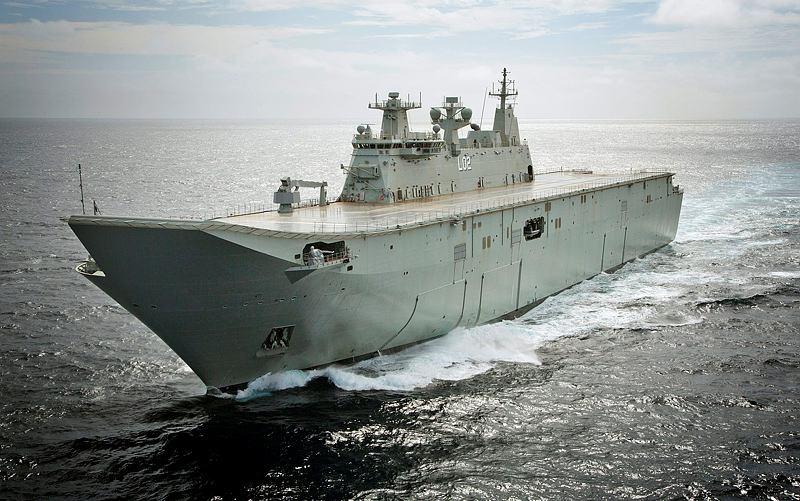The LHDs and air power: the rotor-wing option
Posted By Albert Palazzo and Antony Trentini on February 17, 2015 @ 06:00
As 2014 came to a close, the Strategist hosted a debate on the potential for STOVL jets to operate from the RAN’s new LHDs. That debate followed on from an ASPI Strategic Insights Paper [2] that was written in response to the government’s direction [3] for the 2015 Defence White Paper to address the possible acquisition of the F-35B.
The debate was largely one sided, and tended to focus on the cost and utility of the ADF’s fielding what could be termed a ‘mini aircraft carrier’. The debate was also notable for its lack of lateral thinking. Only one offered an option [4] that considered air power from the perspective of anything other than fast jets. None suggested using LHD-based air power in anything other than the support of an amphibious operation.
While it would be possible to convert one or both of the LHDs into an F-35B platform, it seems to have been forgotten that these ships are already rotor wing ones. If Australia is to exploit the potential of the LHDs to project power in the air, it would be more practical to enhance their existing strength as a helicopter platform than to think up ambitious new capabilities. The most strategically significant way in which Australia could exploit the latent air-power capability of its LHDs is as anti-submarine warfare (ASW) platforms.
As a trade dependent nation [5], Australia believes the security of the global maritime commons [6] is paramount. Protection of the nation’s sea lines of communication has been identified as one of the key requirements of Australia’s maritime strategy [7]. Merchant ships face many threats: land- and air-launched missiles, mines, interception by surface warships, and even seizure by pirates. But as the Battle of the Atlantic [8] demonstrated, the greatest threat to maritime trade is the submarine.
Submarines could lurk in the vastness of the Indian and Pacific Oceans, as they once did in the Second World War, and quickly paralyse trade. Some ASW protection could be provided by land-based maritime patrol aircraft, but an ASW LHD would offer greater persistence, a benefit of particular relevance to shipping traversing lonely trade routes distant from shore. An ASW capability would also be attractive to Australia’s allies who have an interest in the continued freedom of the maritime commons as well.
Admittedly, like an F-35B acquisition, obtaining an ASW capability for the LHDs wouldn’t come cheaply. The RAN would have to perhaps double its rotor-wing fleet with a commensurate increase in crew, training, maintenance and sustainment costs. But, significantly, ship redesign should be relatively limited, maybe additional stowage for sonobuoys and torpedos. Perhaps the most difficult modification would be more fuel bunkerage, if that was needed. But any upgrade would not prevent the LHDs still being available for amphibious duties as required.
The LHDs will give Australia a superb amphibious capability, but realistically, one that will see use only in relatively benign environments, or as part of a disaster and/or humanitarian response. STOVL have no place in such a scenario. But if Australia does want to project maritime air power it’d be better to augment an existing strength than to design an entirely new one. The LHD is as natural an ASW platform as it is an amphibious one. Perhaps it is time to emphasis the ‘H’ in LHD.
Albert Palazzo is the Australian Army’s director of research. Antony Trentini is an employee of the Department of Defence. The views expressed here are their own and do not necessarily reflect those of the Department of Defence or the Australian Government. Image courtesy of Department of Defence [9].
Article printed from The Strategist: https://aspistrategist.ru
URL to article: /the-lhds-and-air-power-the-rotor-wing-option/
URLs in this post:
[1] Image: https://aspistrategist.ru/wp-content/uploads/2015/02/20140313ran8566787_017.jpg
[2] Strategic Insights Paper: https://www.aspistrategist.ru/publications/strategic-insights-78-jump-jets-for-the-adf
[3] government’s direction: http://www.smh.com.au/federal-politics/political-news/jump-jets-on-navys-agenda-as-tony-abbott-orders-air-strike-rethink-20140603-39gl0.html
[4] Only one offered an option: https://aspistrategist.ru/if-not-jump-jets-how-about-unmanned-aerial-vehicles/
[5] trade dependent nation: http://dfat.gov.au/publications/tgs/index.html
[6] global maritime commons: http://www.lowyinterpreter.org/post/2014/11/11/Defence-challenges-2035-Securing-Australias-lifelines.aspx?COLLCC=2147744295&
[7] Australia’s maritime strategy: http://www.defence.gov.au/whitepaper/2013/
[8] Battle of the Atlantic: http://www.bbc.co.uk/history/worldwars/wwtwo/battle_atlantic_01.shtml
[9] Department of Defence: http://images.defence.gov.au/20140313ran8566787_017.jpg
Click here to print.
